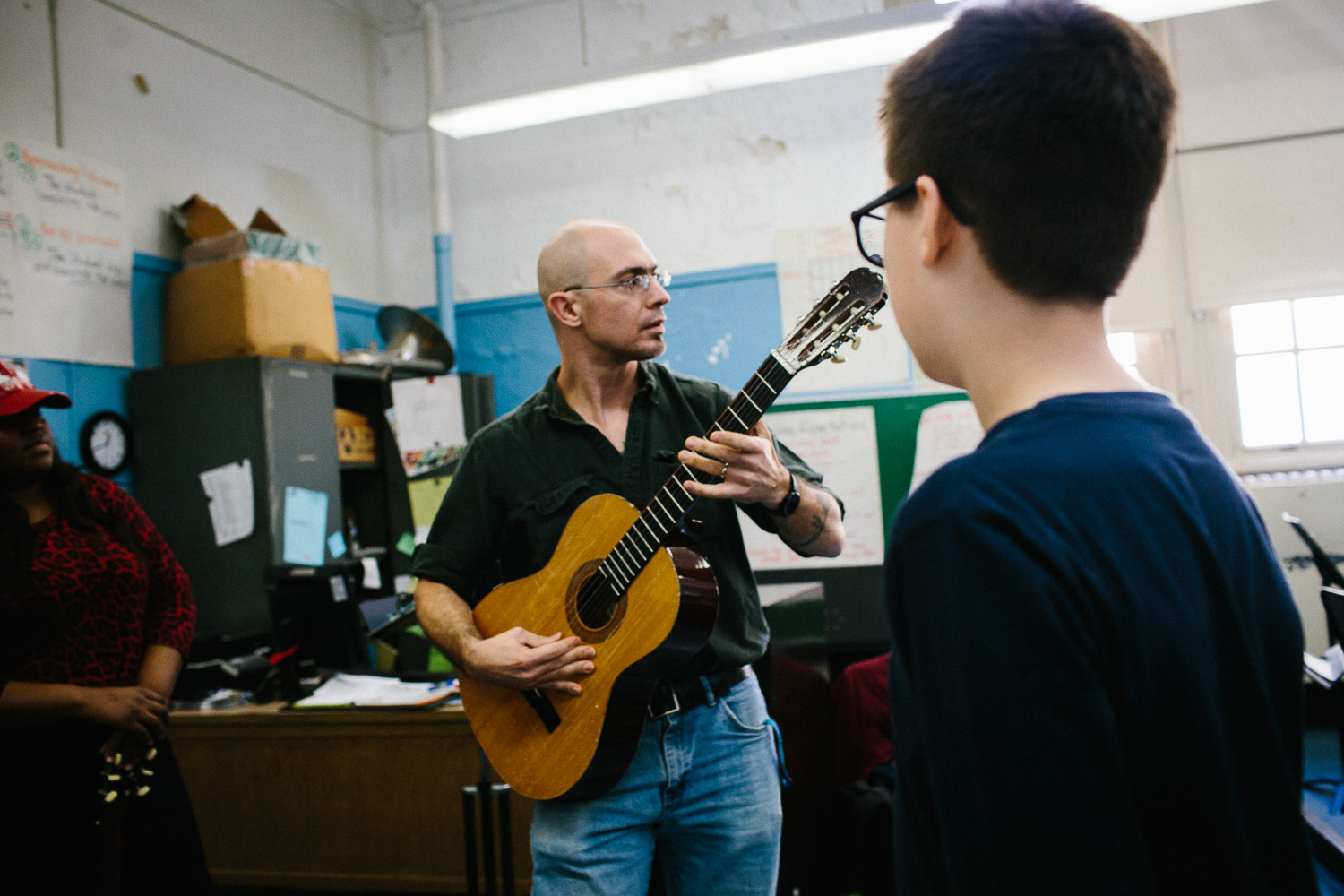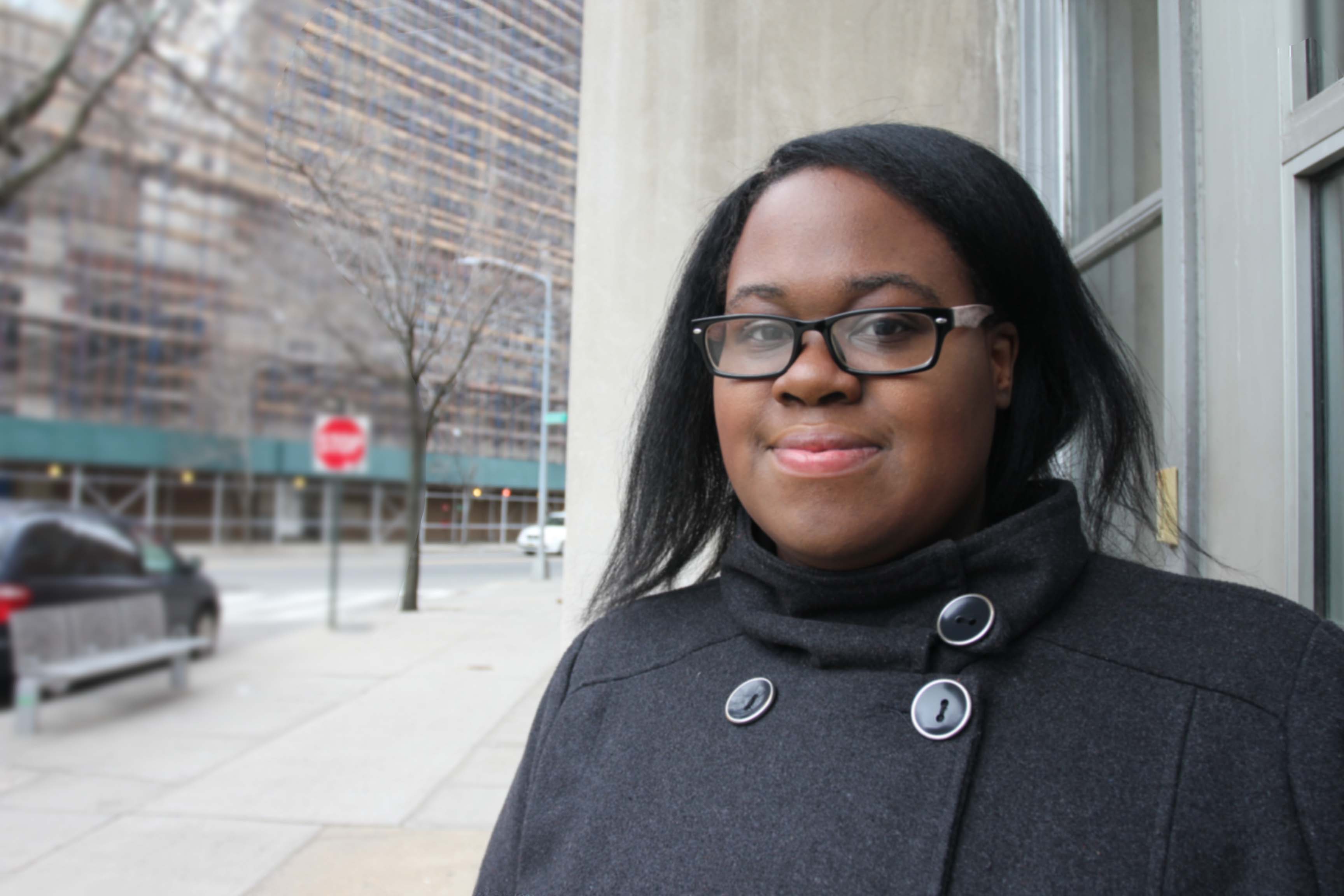Tim Hatlee’s a student teacher. And now his own students are, too.
“We’re doing a group project and we have to basically put together a lesson plan,” said Deana Consuegra, 15, one of Hatlee’s students at DeWitt Clinton High School in the Bronx. He’s spending the semester training to become a teacher. He’s found that the way he’s learning works for his students, too.

“So he gave us an example of the lesson plans that he does,” she said. “He said it doesn’t have to be as detailed, but somewhat like it. So we’re going to teach the whole class about our quadrilateral.”
Other groups had shapes like the square, rectangle, and parallelogram. And within a couple days, these freshmen would be in front of their geometry class, just like Hatlee is every day.
“Instead of me up at the board saying, alright, a square is this four-sided figure with these properties, instead I’m kind of, you know, trying to put that responsibility on the students,” Hatlee said.
In class, he’ll say things like, “This is a square: It’s got four sides: what do you know, what don’t you know? Where have you seen squares before?” That’s an attempt to tap into what his students already know and use that as the jumping-off point for new material.
Hatlee, 26, has a master’s degree in meteorology from Penn State and he spent a year on staff at NASA. But that job wasn’t working for him.
“I decided after a year that the 9-to-5 desk job just wasn’t for me, and said, ‘OK, I can’t do this anymore,’” he said.
Teaching, though, seemed like a good alternative. He’d actually done it before — and he’d really liked it. Back at Penn State, he taught an Intro to Meteorology to non-majors.
“It was mostly freshmen, so it was kind of kids in that 18 to 19-year-old range and I really had a lot of fun doing that,” Hatlee said. So when he got thinking about changing jobs, he knew what direction to head.
He did some Googling, looking for programs that could help him make the transition to teaching. He found a program he’d never heard of before, one called Math for America. They’d pay for a year at City College, provide training sessions, and give him a stipend of $40,000.
“They seemed to have a lot more support than Teach for America and the other programs like that,” Hatlee said. “That’s really important that you have this support behind you, this collaborative sort of environment where you’re relying on other teachers. And that’s what really caught my eye – the support that they give you.”
Hatlee and his wife moved up to New York in June, and he dove right into classes. Once city schools started their fall semester, Hatlee started student teaching. He was at a Brooklyn high school Monday through Thursday, then back in his own classes Fridays.
In January, Hatlee was assigned to a new school, DeWitt Clinton High School in the Bronx. It was vastly different from his first school, the Urban Assembly for Law and Justice. That school had a couple hundred kids; DeWitt Clinton has more than 3,000.
At DeWitt Clinton, he teaches with math teacher Howard Stern, who’s also part of Math for America. They call him a “master teacher,” and train him to be a leader in his math department and for teachers citywide. And though Hatlee teaches most of his classes these days, it doesn’t mean Stern suddenly has a bunch of free periods. He’s carefully watching over the class, identifying what Hatlee does that works — and what doesn’t.
“Occasionally during class I’ll comment,” Stern said. “But usually it’s after class – I hold my comments and I say, ‘This would move smoother if you mentioned such and such, or this needs a drawing.’ But for the most part, he’s teaching the classes.”
It’s clear to a lot of education officials and reformers that New York City — and the nation as a whole — needs a lot more teachers like Hatlee. A couple years back, in 2011, President Obama made this a key part of his State of the Union address.
“Over the next 10 years, nearly half of all new jobs will require education that goes beyond a high school education,” Obama said. “And yet, as many as a quarter of our students aren’t even finishing high school. The quality of our math and science education lags behind many other nations.”
That’s why groups like Math for America are trying to train as many math teachers as possible, and are working to make teaching a more appealing career for the kind of smart person who’d otherwise take good jobs in math and science fields. They do that through a lot of support and training, but also through stipends in addition to city salaries. Hatlee’s getting paid $40,000 this year, on top of a full ride to City College, and he’ll get $15,000 each of the next four years. That’s on top of what he’ll be paid by the city. Every teacher in the program gets paid a bonus of from $5,000 to $15,000 a year.
The program was founded back in 2004, and this year it announced a big change. This is the last year they’re going to offer the fellowship that Hatlee and about two dozen other new teachers are in right now. John Ewing, who heads Math for America, said it’s all about scale.
“There are two ways to get great teachers,” Ewing said. “One is to push them in with programs that find raw talent, teach them to be teachers, put them in the classroom, support them, and hope that they become better. And we’ve done that and I think we’ve gone a good job with it.”
Ultimately, 25 new teachers a year just wasn’t cutting it.
“It’s hard work doing that,” he said. “It’s really hard work doing that, and in the end it’s always going to be limited. If we put 25 new teachers in the classroom every year, that’s great — it’s better than zero — but it’s going to take a long time to make changes.”
Instead, Math for America is focusing on ways to help out teachers already working, and in doing so make the profession more appealing to people considering the switch. Over the next couple of years, the group wants to grow its 600-strong teacher corps to about 1,000. That’ll be roughtly 10 percent of the city’s teachers in these fields. They’re also expanding their focus to include science teachers and they’re working on ways to connect teachers who for so long have worked separately.
As for Hatlee, he’s just focused on being the best teacher he can be. For him, that’s all about making sure his students not only learn what he’s teaching them, but become curious for more.
“When they start asking me about why it’s important, and start asking me about things outside the classroom, or ‘Well, does the math tie into this or to that?,’ that’s when I feel like it’s been a really good day.”



